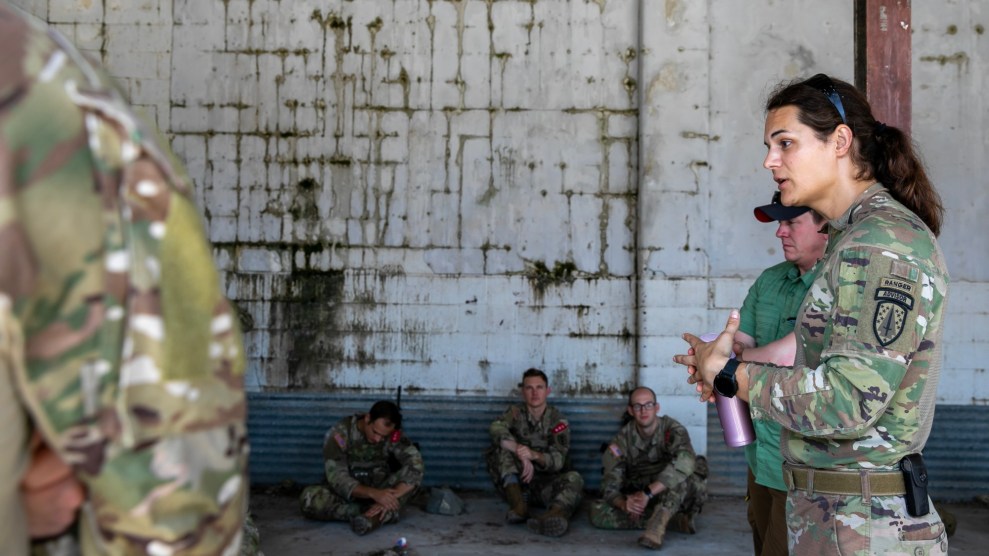
Image: Adreanna Lynn Seymore
According to a recent report by Amnesty International, as many as 1,000 human-rights violators from around the world live in the United States. Like the former Nazis who made headlines in the 1970s and ’80s, most of them lead quiet lives on suburban culs-de-sac and in gated retirement communities. One Haitian general implicated in the murder of hundreds of opposition members got a job at Disney World.
But unlike former Nazis—who for decades have been subject to a concerted federal effort to find and deport them—most retired torturers have little to fear from the U.S. government. The Immigration and Naturalization Service has stepped up efforts to deport those who violate immigration law, but the agency says it cannot expel people on human-rights grounds alone. And while the Justice Department is charged by law with prosecuting human-rights violators in the criminal courts, the department has not filed a single such case. Which means that as long as they keep their heads down and their visas current, most former torturers can live in the United States, comfortably, for as long as they choose.
Unless, that is, they have the bad fortune of being snared by a small but growing network of victims, private investigators, and human-rights advocates who have set out to do what the government seldom does—track down human-rights criminals and bring them to justice. In some instances, their investigations have convinced the INS to look into an offender’s immigration status; in others, victims have taken their former persecutors to court. In one recent civil case against two Salvadoran generals accused of supervising the torture and murder of thousands, a Florida jury awarded more than $50 million to the survivors.
Richard Krieger also came to southern Florida to retire—but instead of working on his golf game, he has been honing the investigative skills he first learned while tracking Nazis in the 1970s. From their den in Boynton Beach north of Boca Raton, Krieger and his wife run a tiny nonprofit dedicated to locating human-rights abusers who live in the United States. “Either we are a country that’s dedicated to liberty and freedom,” he says, “or we are a country who doesn’t care who we deal with and who we give sanctuary to.” So far, he has given the INS dossiers on more than 50 people, 12 of whom have been arrested.
A barrel-chested, 69-year-old Bronx native with salt-and-pepper hair, a tan, and a thin gold chain around his neck, Krieger came to Florida in 1998, after leaving the State Department, where he served as associate coordinator for refugee affairs. Traveling to refugee camps around the world, he recalls, “I found an awful lot of people that really had been through hell just because they were living in the wrong country at the wrong time. And these guys who were perpetrating these atrocities, these guys like [Ugandan dictator] Idi Amin, were going off to live somewhere in comfort, having left millions of people dead, families slaughtered.”
Over the past three years, Krieger has assembled a kind of national map of thugs—when I tell him where I live, he answers, “Now in Austin, you have four guys from Sierra Leone.” He refuses to discuss the details of cases, acknowledging only that he has “a lot of informants, a lot of people who like me and want to talk to me.” And, he notes, offenders aren’t necessarily hard to find. In one case, Krieger obtained a list of 40 human-rights violators who had been expelled from Canada, then ran some of their names through U.S. public-records databases. He found 14; all of them, he says, are still in the United States.
Krieger pursued his first war criminal 30 years ago—in 1973, when he headed the Jewish Community Council in Flint, Michigan. One day, he got a call from a reporter, who told him that Valerian Trifa, a top Nazi collaborator from Romania, was living in the area. “What are you doing about it?” the reporter asked. Krieger tracked Trifa down and gave the INS his address, launching what would be the first in a string of frustrating encounters with the agency. “The INS did not act,” he recalls. In fact, he later learned, the immigration service had a list of 53 alleged Nazi perpetrators living in the United States, but had deported only one. It wasn’t until 1978 that Congress required the Justice Department to locate former Nazis and expel them; in the 25 years since, the department has investigated more than 1,600 suspected Nazis and deported 65.
The office’s purview, however, is limited to World War II-era criminals; other human-rights abusers are the domain of the National Security Unit, a special INS office created five years ago to target human-rights criminals who violate immigration rules. The INS won’t say how many cases it has investigated. But the unit’s former director, Walter Cadman, told Amnesty International two years ago that his staff had a list of nearly 200 suspected perpetrators, and that more than 30 had been deported.
Advocates laud the INS for creating the unit but note that its resources are limited—especially since the same office is also responsible for investigating suspected terrorists. “The U.S. government is adept at taking people into custody,” Amnesty USA’s executive director, William Schulz, said last year, “as it has shown by its detention of some 1,200 individuals following the attacks of September 11, the vast majority of whom have been charged only with visa violations. How ironic that we have been unwilling to move against people…who there is good reason to believe are responsible for far more serious crimes.”
For most of the past century, the United States has been a vocal advocate of prosecuting war criminals through international law. But last year, the Bush administration withdrew the U.S. signature from a treaty establishing the International Criminal Court—the first permanent venue dedicated to prosecuting crimes against humanity. Administration officials said they feared that U.S. soldiers could face prosecution overseas; nonetheless, they stressed, the United States would ensure that “persons wanted or indicted for genocide, war crimes, or crimes against humanity [could not] seek safe haven on our soil.”
In fact, the U.S. government has not only failed to pursue many human-rights criminals who found refuge in this country—it has, in numerous cases, helped bring them here. In 1949, Congress passed the so-called 100 Persons Act, authorizing the CIA to admit up to 100 people a year “in the interest of national security,” even if those people were war criminals barred from immigrating. At the time, the CIA sought to recruit Nazi collaborators from Eastern Europe who could provide information about the Soviets. But the authorization was never repealed, and as recently as two years ago a “high-ranking intelligence-community source” confirmed to the Atlantic Monthly that “on the high end of the spectrum, the director of the CIA can bring in fifty to a hundred people in the top spy category. Lower down, you can do everything from a little help around the edges to supplying visas.”
Among those who appear to have benefited from covert immigration help is a group of commanders from Haiti, members of the infamous military regime that ruled the country from 1991 to 1995. An estimated 3,000 to 5,000 civilians died during that time; a paramilitary group called the Front for the Advancement and Progress of Haiti (FRAPH), led by Toto Constant, became known for “facial scalping,” skinning victims with machetes. In April of 1994, soldiers and FRAPH members attacked the fishing village of Raboteau, killing at least 15 people. Later that year the Clinton administration sent troops to the island, and the junta agreed to step down.
Five years later, a Haitian court sentenced Constant to life in prison for his role in the Raboteau massacre. But by then, Constant had moved to Queens and gotten his real-estate license. The State Department refused to send him back to Haiti, saying that his presence would jeopardize democracy there. He is still living in the United States.
Another of the junta’s leaders, Carl Dorelien, came to the attention of his former victims in Miami’s Haitian community in 1997, when he won $3.2 million in the Florida lottery. At the time, Dorelien said he’d come over on a visa the American military attaché to Haiti had personally delivered to his house. In all, Dorelien said, 16 former members of the Haitian regime had moved to the United States. Some of them have since been deported; in January, Dorelien and former Colonel Hebert Valmond, who had overstayed their visas, were sent back to Haiti, where they will face trial for their roles in the Raboteau massacre. “I’m someone who’s frequently a critic of the United States government,” says Brian Concannon Jr., a lawyer with the Bureau des Avocats Internationaux, which has helped bring alleged perpetrators to trial in Haiti. “But the INS has done a very good job of going after Dorelien and some other guys.”
Still, most of the former Haitian officials have been able to stay in this country. One of them, Jean-Claude Duperval, was working at Disney World when Richard Krieger tracked him down in 2001.
In December 1980, investigators pulled four bodies from a shallow grave along a remote road in El Salvador. They were Jean Donovan, Dorothy Kazel, Ita Ford, and Maura Clarke—three American nuns and a lay worker who had come to El Salvador to minister to the poor, even as the country’s military junta launched a bloody campaign against leftists and their “sympathizers.” The women had been abducted, raped, and killed by members of El Salvador’s national guard. The murders made headlines around the world.
Thirteen years later, a truth commission established by El Salvador’s new civilian government issued a report naming dozens of top officials responsible for atrocities during the late 1970s and early ’80s. High on its list were two generals, Jose Guillermo Garcia and Carlos Eugenio Vides Casanova, formerly El Salvador’s defense minister and national guard chief, respectively. But the truth commission hadn’t been able to interview Garcia and Vides Casanova; they had settled in Florida in 1989, having come to the United States on legal, U.S. Embassy-issued visas. In 1999, relatives of the churchwomen filed a lawsuit against Garcia and Vides Casanova, but the men successfully argued that they could not be held responsible for the actions of rogue subordinates.
By last summer, however, the generals’ luck had run out. They were in court again, facing claims from three victims of military abuses, including a doctor who had been tortured in the Salvadoran national guard’s headquarters. A jury concluded that Garcia and Vides Casanova held “command responsibility” over the crimes. They were ordered to pay their victims $54.6 million.
The Garcia/Vides Casanova verdict was a watershed, says Patty Blum, a professor of human-rights law at the University of California-Berkeley who worked on the case. “A very important aspect was that the three plaintiffs felt their voices were not singular—it was not just them as survivors, but they got to speak for the voiceless.”
In practice, it is unlikely that the victims will ever collect anywhere near $50 million from the two men. Nor, it appears, will the generals face any other punishment. Both still live in Florida, and there are no deportation proceedings against them.
The only way to fully hold men like Garcia and Vides Casanova accountable, human-rights advocates argue, is prosecution in criminal court—something the U.S. government is required by law to pursue, at least in some cases. In 1988, President Reagan signed the international Convention Against Torture, which obligates member countries to find, extradite, or prosecute alleged torturers. Congress ratified it in 1994, along with a law assigning the task of pursuing alleged offenders to the Justice Department. Since then, human-rights advocates and the INS have forwarded several dozen names of foreign perpetrators to Justice officials, but no charges have been filed. The department won’t comment on whether it is investigating any of the cases.
Criminal charges could be far more effective in dealing with human-rights abusers than immigration proceedings, notes William Aceves, the principal author of last year’s Amnesty report and a professor at California Western School of Law. In criminal trials, the accused could mount a full-fledged defense and victims would be able to confront their abusers in a public forum. In the long run, he says, “it would uphold the rule of law not only in this country, but in the country where the torture occurred”—perhaps even deterring future crimes.
One day in 1996, Gerald Gray, a San Francisco therapist who treats torture survivors, was contacted by a refugee from Bosnia. The man told him that he had just spotted one of his torturers—in a photo taken at a local party. “I realized that this was a problem we never paid attention to,” Gray recalls, “and I really lost my temper. It meant we couldn’t really succeed, that [healing] couldn’t be complete if people felt they were still under threat.”
In response, Gray founded the Center for Justice and Accountability, which helps torture survivors and relatives of the disappeared sue human-rights violators in civil court. The center has investigated more than 100 cases, and it has helped victims file seven lawsuits, including last year’s case against the Salvadoran generals. This year, it expects to face off against Armando Fernandez Larios, a former Chilean secret agent who is accused of participating in the “Caravan of Death”—a grisly episode during which a group of military officers massacred 72 prisoners in a series of cities in northern Chile. Fernandez Larios has lived in Miami since 1988. Both Chile and Argentina have asked for his extradition to stand trial on other human-rights charges, but so far the United States has refused.
Fernandez Larios’ case is unusual, for most human-rights offenders are never charged with any crimes in their home countries. In some countries, military rulers have issued amnesties for their associates before leaving office. In others, civilian governments have established truth commissions with the power to investigate but not to prosecute.
That’s what happened in Honduras, and it’s why a lawsuit in the United States is probably the only chance Juan Lopez Grijalba’s victims will ever have to confront him in a court of law. Oscar and Gloria Reyes are among those who hope to take the witness stand once that happens; another plaintiff is Zenaida Velasquez, whose brother Manfredo was kidnapped by the Honduran military in 1981 and never heard from again.
Velasquez, who lives in San Jose, California, says she heard about the case through a friend in Honduras and decided to join in&38212;even though the attorneys warned her that the process would be long and difficult. “We have always been complaining about the impunity that these people have been enjoying,” Velasquez says. “No one has done anything to them, and I don’t want to allow their impunity any longer.”
In his defense, Grijalba has maintained that he didn’t directly supervise the officers involved in torture. His attorney, Kurt Klaus&38212;who also represented the Salvadoran generals in last year’s trial—says the lawsuits amount to scapegoating. “Who gains from these cases?” he asks. “How does it go to helping the people of Honduras? The justice system and infrastructure of those countries need to work, instead of trying to sue a general for something he did 20 years ago. There’s no way it’s going to be done years after the fact. There are too many unbridged gaps in the evidence; the people who actually did the torture are nowhere to be found; and you get a trial of experts trying the history of Latin America.”
But a more precise accounting of history, one that publicizes the record and identifies the perpetrators, is precisely what plaintiffs and their supporters are after. In the end, says Oscar Reyes, it doesn’t so much matter to him whether Grijalba is tried in the civil suit or whether he is deported first. “I just want a judge to condemn him on human-rights grounds, either in court or by him being expelled. I want justice to say this is wrong, what you did.”
Grijalba’s deportation hearings are scheduled to conclude this spring; the witness list, according to sources familiar with the case, included several former U.S. military and CIA officials. When Mother Jones sought access to the hearings, the immigration judge ordered the proceedings closed. The Justice Department has not responded to a Freedom of Information Act request for information related to the case. Grijalba, through his immigration attorney, declined to be interviewed.
For now, Grijalba remains at the Krome Detention Center in western Miami-Dade County—dusty, flat territory where the housing developments peter out and signs for swamp tours and the Miccosukee Indian casino beckon along a narrow highway. If it weren’t for the concertina wire atop the chain-link fence, Krome could pass for an elementary school from the mid-20th century, a low-rise complex of cream-colored cinder block and turquoise trim, flanked by perfunctory green lawns and a large American flag. Inside are cramped courtrooms, and it was in one of those small chambers that Oscar Reyes saw Juan Lopez Grijalba for the third time, this past January.
Reyes had come to testify at Grijalba’s deportation hearing, in support of the INS’s contention that Grijalba should be sent back to Honduras. For close to two hours he told his tale, sitting in a chair just a few feet away from Grijalba; at one point the translator—who wasn’t occupied because Reyes spoke in English—began to cry. Grijalba “was very tranquil,” Reyes says. “Sometimes I saw him looking at me. He’s older now, with gray hair. He was wearing jeans and a red-and-blue shirt, plain clothes. He’s lost weight. In uniform they are big guys, arrogant, but now he was humble.”















